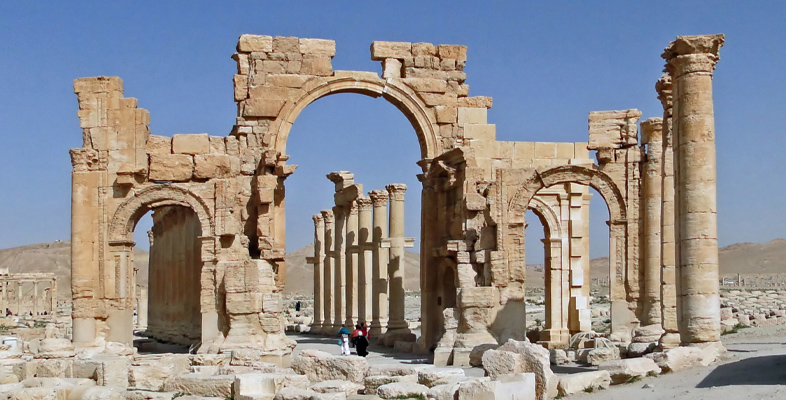1 The inseparability thesis
In recent years, the world has seen some high-profile acts of destruction taken against cultural heritage. Most recently, in 2015 in Syria, ISIS attacked and seriously damaged several important sites in Palmyra, including the Monumental Arch, the Temple of Bel and the Temple of Baalshamin.
Activity 1 Map of Palmyra
The map accessed via the link below shows the site of the ancient city of Palmyra, just southwest of the modern city of Tadmur. Palmyra was valued as one of the best-preserved ancient cities in the geographic area and was sometimes called ‘the pearl of the desert’. Highlighted are three of the most significant monuments attacked by ISIS. Click the icons and follow the ‘Explore’ links to see an interactive 3D image of each site before it was destroyed.
Map of Palmyra [Tip: hold Ctrl and click a link to open it in a new tab. (Hide tip)] (make sure to open this link in a new tab/window so you can easily return to this page).
Discussion
These structures all date back to the 1st or 2nd Centuries CE. At that time Palmyra was a bustling trading hub, owing to its prime location for merchants. The wealth of the city was what allowed it to create such impressive feats of architecture. Besides their age and size, the buildings were also considered especially valuable because they expressed both Roman and Eastern influences. For instance, you may have noticed the Roman-style columns on both the temples and the colonnade following the arch. Sadly, however, what remains of these buildings are three piles of rubble.
The international community reacted to Palmyra’s destruction with horror. Many writers and organisations argued that more should be done to protect heritage from such attacks.
At the same time, other commentators pointed out that the war in Syria was also producing a massive human cost: deaths, injuries and displacement of people on a vast scale. They asked:
- Was this reaction to the destruction of a few ancient structures not out of proportion?
- Should we not be more concerned about the loss of human life than the loss of these pieces of cultural property?
- Why direct troops to protect mere monuments when there are people who need protecting elsewhere?
In response to this criticism, several spokespeople defended themselves by asserting what can be called ‘the inseparability thesis’. For example:
- President Hollande of France: ‘Should we be concerned about the patrimony? What is more important, saving lives or saving stones? In reality, these two are inseparable’ (Simons, 2016).
- Irina Bokova, UNESCO’s Director-General: ‘Defending cultural heritage is more than a cultural issue – it is a security imperative, inseparable from that of defending human lives’ (UNESCO, 2017).
- Thomas Weiss and Nina Connelly: ‘The protection of people and the protection of heritage are inseparable … [T]here is no need for a hierarchy of protection because the choice between the two is false, just as a choice between people and the natural environment is false. Air, water, and culture are essential for life’ (Weiss and Connelly, 2017).
The inseparability thesis essentially claims that protecting cultural property and protecting human beings are, in important respects, indistinguishable. Therefore, no one can be criticised for being more concerned about cultural heritage than human beings, or for recommending intervention on behalf of heritage at the expense of people’s lives. This is because the projects of protecting heritage and protecting people are inextricably and intimately connected in such a way that they cannot be disentangled.
The inseparability thesis denies the existence of the puzzle which this course has been circling: that sometimes the protection of human lives and the protection of cultural heritage come into genuine competition. And that we must work out how to compare and weigh up the value of these two goals in order to make decisions about such conflicts.
Instead, the inseparability thesis holds that there is no real need to weigh up the value of heritage against the value of human life. Given that the protection of heritage and the protection of life are inseparable, it makes no sense to worry about comparing one against the other. In practice, the defence of heritage and the defence of people are one and the same.
There is something quite odd about the inseparability thesis if you take it literally. How can the protection of heritage be the same as the protection of human lives? In an attempt to understand it, Erich Hatala Matthes (2019) has provided several different interpretations or ‘readings’ of the thesis which you can consider next.
